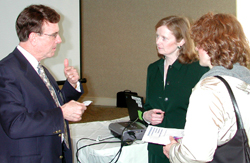|
Creative Necessity: An Economic Impact Study of Arts and Cultural Organizations in East King County
|

Doug Cameron and Wendi Fischer (R) talk with Mary Pat Byrne after Friday’s meeting.
|
Norm Johnson introduced Mary Pat Byrne, Arts Specialist for the City of Bellevue since 1987, and Doug McCallum, President of Eastside Arts Coalition and a member of the Rotary Club of Bellevue. Doug said his “abiding love for the arts and the link between arts and business” has always been an interest of his. “But, who benefits most from this association?”
The Eastside Arts Coalition commissioned an “Economic Impact Study of Arts and Cultural Organizations,” released in the Fall of 2001. Some of the participating organizations include the Coalition, Bellevue Arts Commission, Bellevue Chamber Foundation, Corporate Council for the Arts, Issaquah, King County, and Redmond Arts Commissions, and Music Works Northwest. “There is a synergy between arts and business,” McCallum observed. “Business wants to be where things are going on. So, in 1992, the Corporate Council for the Arts hired GMA Research to do the first study. It was upgraded in 1997 and covered King and Pierce Counties. The data collected was extracted to determine the impact of Eastside arts from a study done in 2000.
Mary Pat Byrne was called upon to explain “how the Eastside breaks out of the original impact studies. What do the arts mean to the community? Using the Washington State input-output model, the study provides estimates of business activity levels. Using that model, the estimates are provided for the state and specific counties. To get data for only the Eastside, a further study was conducted.”
- The Numbers. In 2000, spending by arts organizations and patrons created a business activity of $40 million. There were 2,452 jobs and a tax impact of $2 million. Patron spending reached $15.2 million and organization budgets were pegged at $15 million.
- New Money Impacts. Some of the most significant numbers were gained by the bringing of artists into the county for performances, amounting to $4 million and 238 jobs.
- Earned and contributed income. Earned income through ticket sales, admissions, tuition, retail sales, and other sources accounts for 59% of the total of earned income. Corporate and government account each for 5%, while 7% comes from individuals.
- What do we spend the money on? Mostly on people – 50% is spent on employees. Arts groups operate with minimum staffing. Only 6% are full-time, 46% part-time, and contractual workers make up 46% of the total. The other 50% of expenditures goes to operating expenses.
- What did the patrons tell us? There were 743,000 admissions to events sponsored by Eastside cultural organizations in 1999/2000. This figure does not include festivals, only the activities of museums and performing groups. Arts groups give tickets away to those who can’t afford them. Patrons are not buying annual blocks of tickets. Patrons to performances come mostly from the Eastside (75%), while the balance comes from other areas of King County and beyond.
Kemper Freeman’s plan to build a $60 million performing arts center in close proximity to all the services that arts patrons require, such as eating and lodging facilities, will bring together a plan that has been a long time coming on the Eastside.
Of patrons surveyed who had children, 73% reported their children’s participation in art education outside their school. There were 900 courses offered in 2000 by Eastside arts organizations: 8,400 kids attended classes, and 5,300 adults were enrolled.
Mary Pat said the future will bring another study in five years. “Population will grow and demand will intensify. Arts groups will continue to mature, and new facilities will be built. These are ‘quality of life’ issues, where people recognize the impact of arts programs.”
Doug McCallum recommended participation in the Corporate Council on Arts (CCA) for any businesses wishing to impact the growth of the arts. “It was founded in 1969 and serves as a sort of United Arts Fund. Some $2.5 million per year has been appropriated for arts programs and $2.4 for building projects on the Eastside. A Board of Trustees numbering 60 people, with 11 from the Eastside, oversees the CCA. Rigorous qualifications are in place for arts organizations to get grants from the CCA.
Asked about new venues in 10 years: The planned 1,800-seat performing arts hall in Bellevue will be in place, but an area needs “all kinds of venues to satisfy needs of different organizations. Unfortunately, there are few affordable spaces for facilities on the Eastside. There is also a children’s museum on the drawing boards, and Eastside Heritage is being formed, which will merge the various historical societies.”
For an interesting look at the impact of the arts on the Eastside, Mary Pat and Doug were given a certificate showing that 700 pounds of food has been given in their name to Rotary First Harvest.
|